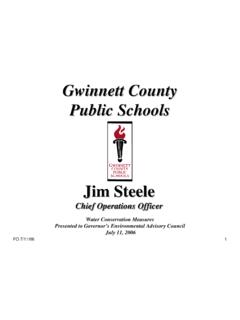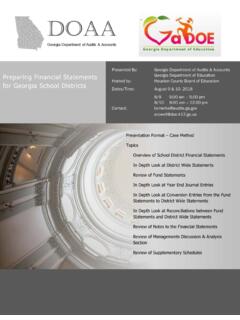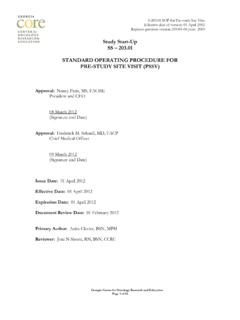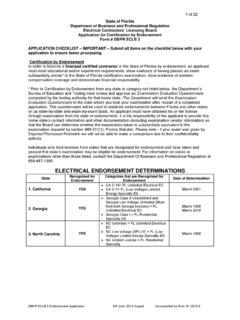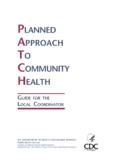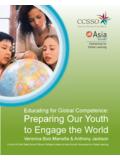Transcription of WATER CONSERVATION EDUCATION PROGRAMS
1 1 Guidance Document WATER CONSERVATION EDUCATION PROGRAMS August 2007 WATER CONSERVATION EDUCATION PROGRAMS EPD Guidance Document August 2007 TABLE OF CONTENTS Part 1: Making the Case for WATER CONSERVATION Education_____ 3 Part 2: EDUCATION PROGRAMS for WATER System Employees_____ 4 Steps to build CONSERVATION awareness among 4 Part 3: Public EDUCATION and School Programs_____ 5 Goals of a Public EDUCATION Program_____ 5 Building Public Awareness and Understanding _____ 6 Specific Tools for Building Public Awareness and Understanding for CONSERVATION _____ 7 School PROGRAMS : Building Knowledge and Understanding _____ 11 Specific Tools for Students _____ 11 Part 4.
2 CONSERVATION EDUCATION Program Checklist_____ 14 For Public Awareness and Understanding for CONSERVATION _____ 14 For Student Education_____ 15 georgia Environmental Protection Division Watershed Protection Branch 2 Guidance Document WATER CONSERVATION EDUCATION PROGRAMS August 2007 Guidance Document WATER CONSERVATION EDUCATION PROGRAMS Developed by the georgia Environmental Protection Division (EPD) To support the Coastal georgia WATER and Wastewater Permitting Plan for Managing Saltwater Intrusion August 2007 This guidance document is intended for entities in the 24-county area of georgia s coast addressed in the Coastal georgia WATER and Wastewater Permitting Plan for Managing Saltwater Intrusion , located in Sub-Regions 1, 2 and 3.
3 It applies to municipal groundwater users, and the following categories of public/private drinking WATER suppliers: Public Community WATER Systems (CWS) with WATER Withdrawal and/or Operating Permits; Governmentally Owned or Operated Public Drinking WATER Systems with an Operating Permit; or Governmentally Owned or Operated Transient Non-Community (TNCWS) or Non-Transient Non-Community Public WATER Systems (NTNCWS) with either an Operating Permit and/or a Withdrawal Permit. Privately Owned or Operated Public Community Drinking WATER Systems with ONLY an Operating Permit; It is designed to guide the development and implementation of a WATER CONSERVATION EDUCATION program including WATER system employee training, public information PROGRAMS , and school PROGRAMS .
4 When to use this guidance document: For most Upper Floridan aquifer groundwater withdrawal permittees in the coastal counties of georgia , a special condition of all new or modified withdrawal permits will be development and implementation of a WATER CONSERVATION EDUCATION program. This program must be conducted in accordance with these guidelines and reported to the Division s District Office for concurrence no later than 12 months from the permit issue date. How to use this guidance document: The guidance is organized in three parts: Part 1 Making the Case for WATER CONSERVATION EDUCATION provides the rationale for developing and implementing WATER CONSERVATION EDUCATION PROGRAMS ; Part 2 Developing a Training Program for WATER Syetem Employees presents a general process to educate and train your employees on how to minimize the loss and waste of WATER within the distribution and treatment systems.
5 Part 3 Developing a Public EDUCATION Program presents a general process for developing and implementing the most appropriate CONSERVATION public EDUCATION approach for your area. Part 4 Checklists contains checklists to identify the CONSERVATION EDUCATION PROGRAMS you have implemented. After implementing the items you have checked as part of a comprehensive EDUCATION program, submit this checklist along with any supporting documentation to the appropriate EPD District Office within 12 months of the permit issuance date. Most of the methods described in this Guidance Document will only apply to Governmentally Owned Community WATER Systems. However, other methods can be used effectively by small, privately owned or operated Community WATER Systems.
6 Those methods will be indicated in the text of the document. EPD contact: If you have any questions, or require additional information, please contact the EPD WATER Withdrawal Program, at 404-675-1680. As the July 2006 Coastal Permitting Plan is implemented, EPD will welcome feedback from permittees regarding this guidance document. 3 Guidance Document WATER CONSERVATION EDUCATION PROGRAMS August 2007 Part 1: Making the Case for WATER CONSERVATION EDUCATION WATER is a limited resource. With georgia s populations growing in our urban centers, threatened species being further endangered, and the cost of new WATER sources rising steadily we must learn to use WATER more efficiently and conserve where possible.
7 WATER CONSERVATION is a critical element of any future WATER management strategy. WATER CONSERVATION can help you and your customers save WATER , save time, and save money throughout the year, not just in the summer. It is defined as the beneficial reduction in WATER use, waste and loss and is proven to be the most economical and environmentally protective management tool for meeting WATER supply challenges Virtually all WATER CONSERVATION efforts depend on public awareness and understanding of the need for CONSERVATION . CONSERVATION efforts are only considered successful if results can be measured and results are targeted to the particular type of WATER user ( commercial, residential, industrial and agricultural).
8 Minimizing WATER use, waste, and loss over time is heavily dependant on continually evaluating and adopting new technologies and practices. EDUCATION and technical assistance PROGRAMS are important to inform people about the impact of improved WATER efficiency and WATER CONSERVATION . Without adequate knowledge, WATER users lack the ability to put CONSERVATION measures and practices into place, however motivated they may be. WATER professionals around the country note that successful WATER CONSERVATION PROGRAMS are comprised of multiple components. Individually, each component of a WATER CONSERVATION program can get results, but the most reliable results are obtained by the integration of all components.
9 One of the most critical components of a program is a robust EDUCATION and outreach program that reaches WATER provider employees, school children, and adults. Furthermore, investments in public and targeted EDUCATION have high WATER CONSERVATION returns, and public awareness tends to build political support and participation. The responsibility for ensuring a sustainable WATER future lies with the community as a whole; everyone has a role to play to make sure that all WATER (rainwater, stormwater, public WATER supply, etc.) is treated responsibly and planned for properly. EDUCATION of the public at large, municipal officials and WATER suppliers is crucial to generating an understanding of the issues, and creating acceptance to the implementation of WATER CONSERVATION efforts.
10 It is important to provide to the public the basic understanding of sound WATER resources management and planning and to explain the associated economic and environmental benefits. Public EDUCATION and outreach can be an essential prerequisite to the successful adoption and implementation of CONSERVATION practices. The next two parts of this guidance address two major categories of an educational effort that are critical to building an understanding of WATER CONSERVATION and the impact it can have on businesses, individuals, homeowners, and the environment. Both of these categories should be pursued in order to see the full spectrum of benefits a WATER CONSERVATION program can offer.

